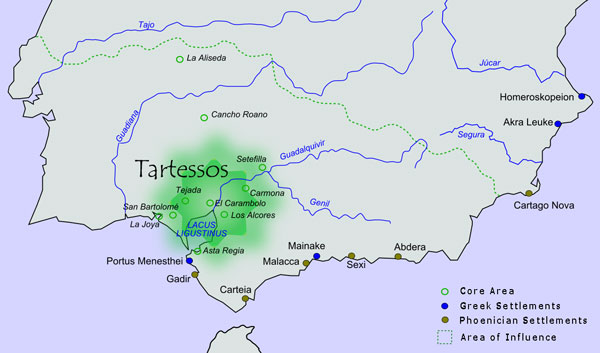Tartessians in Andalucia
Tartessians and the land of Tartessos, fable, legend, myth or a true story? The only 'king' we have heard of is King Argathonius and he was reputed to have lived until he was 140 years of age and been king for eighty of those years. Some researchers have linked Tartessos with Atlantis, thereby doing Tartessos no favours in the credibility stakes. Others still search for the 'lost' city of Tartessos and the unimaginable wealth said to be buried there. It is hard to separate fact from fiction.
However, what is known is that between the 9th centuries BC and the 4th century BC, there was a society living in the valleys of the Guadalette, Guadalquivir and Guadiana rivers, that extended its territory north into Extremadura and had eastern outposts as far east as Acinipo, near Ronda. Could they have been the Tartessians?
 Tartessos was a harbour city and the surrounding culture on the south coast of the Iberian Peninsula (in modern Andalusia, Spain), at the mouth of the Guadalquivir River. It appears in sources from Greece and the Near East starting during the first millennium BC. Herodotus, for example, describes it as beyond the Pillars of Heracles (Strait of Gibraltar). Roman authors tend to echo the earlier Greek sources but from around the end of the millennium there are indications that the name Tartessos had fallen out of use and the city may have been lost to flooding, though several authors attempt to identify it with cities of other names in the area. Archaeological discoveries in the region have built up a picture of a more widespread culture, identified as Tartessian, that includes some 97 inscriptions in a Tartessian language.
Tartessos was a harbour city and the surrounding culture on the south coast of the Iberian Peninsula (in modern Andalusia, Spain), at the mouth of the Guadalquivir River. It appears in sources from Greece and the Near East starting during the first millennium BC. Herodotus, for example, describes it as beyond the Pillars of Heracles (Strait of Gibraltar). Roman authors tend to echo the earlier Greek sources but from around the end of the millennium there are indications that the name Tartessos had fallen out of use and the city may have been lost to flooding, though several authors attempt to identify it with cities of other names in the area. Archaeological discoveries in the region have built up a picture of a more widespread culture, identified as Tartessian, that includes some 97 inscriptions in a Tartessian language.
The Tartessians were rich in metal. In the 4th century BC the historian Ephorus describes "a very prosperous market called Tartessos, with much tin carried by river, as well as gold and copper from Celtic lands". Trade in tin was very lucrative in the Bronze Age, since it is an essential component of bronze and is comparatively rare. Herodotus refers to a king of Tartessos, Arganthonios, presumably named for his wealth in silver.
The people from Tartessos became important trading partners of the Phoenicians, whose presence in Iberia dates from the 8th century BC and who nearby built a harbour of their own, Gadir, present-day Cádiz.

